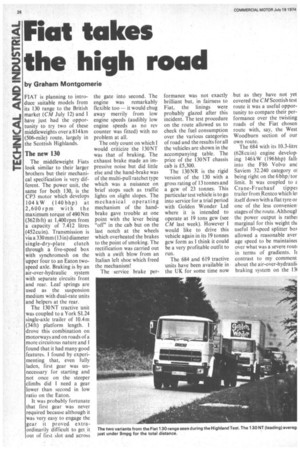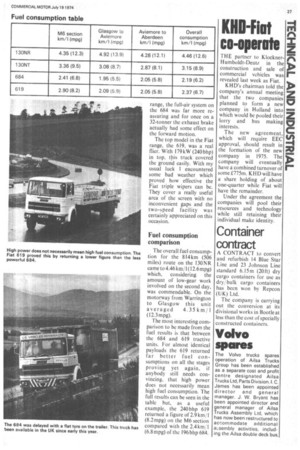Fiat takes the high road
Page 28

Page 29

If you've noticed an error in this article please click here to report it so we can fix it.
by Graham Montgomerie
FIAT is planning to introduce suitable models from its 130 range to the British market (CM July 12) and I have just had the opportunity to try two of these middleweights over a 814 km (506-mile) route, largely in the Scottish Highlands.
The new 130
The middleweight Fiats look similar to their larger brothers but their mechanical specification is very different. The power unit, the same for both 130, is the CP3 motor which develops 104 kW (140 bhp) at 2,6 0 0 rpm with the maximum torque of 490 Nm (3621b ft) at 1,400 rpm from a capacity of 7.412 litres (452cuin). Transmission is via a 330 mm (13 in) diameter single-dry-plate clutch through a five-speed box with synchromesh on the upper four to an Eaton twospeed axle. Braking is by an air-over-hydraulic system with separate circuits front and rear. Leaf springs are used as the suspension medium with dual-rate units and helpers at the rear.
The 130 NT tractive unit was coupled to a York SL24 single-axle trailer of 10.4m (3411) platform length. 1 drove this combination on motorways and on roads of a more circuitous nature and I found that it had many good features. 1 found by experimenting that, even fully laden, first gear was unnecessary for starting and not once on the steeper climbs did I need a gear lower than second in low ratio on the Eaton.
It was probably fortunate that first gear was never required because although it was very easy to engage the gear it proved extraordinarily difficult to get it out of first slot and across the gate into second. The engine was remarkably flexible too — it would chug away merrily from low engine speeds (audibly low engine speeds as no rev counter was fitted) with no problem at all.
The only count on which I would criticize the 13ONT was that of braking. The exhaust brake made an impressive noise but did little else and the hand-brake was of the multi-pull ratchet type which was a nuisance on brief stops such as traffic lights on slight slopes. The mechanical operating mechanism of the handbrake gave trouble at one point with the lever being "off" in the cab but on the last notch at the wheels which overheated the brakes to the point of smoking. The rectification was carried out with a swift blow from an Italian left shoe which freed the mechanism!
The • service brake per formance was not exactly brilliant but, in fairness to Fiat, the linings were probably glazed after this incident. The test procedure on the route allowed us to check the fuel consumption over the various categories of road and the results for all the vehicles are shown in the accompanying table. The price of the 130NT chassis cab is £5,300.
The 130NR is the rigid version of the 130 with a gross rating of 13 tonnes and a gcw of 23 tonnes. This particular test vehicle is to go into service for a trial period with Golden Wonder Ltd where it is intended to operate at 19 tons gcw (see CM last week). However I would like to drive this vehicle again in its 19 tonnes gcw form as 1 think it could be a very profitable outfit to run.
The 684 and 619 tractive units have been available in the UK for some time now but as they have not yet covered the CM Scottish test route it was a useful opportunity to compare their performance over the twisting roads of the Fiat chosen route with, say, the West Woodburn section of our own route.
The 684 with its 10.3-litrc (628 cu in) engine developing 146 kW (196bhp) fall into the F86 Volvo and Saviem 32.240 category ol being right on the 6 bhp/ tor limit. It was coupled to Crane-Fruehauf tippei trailer from.Rentco which tel itself down With a flat tyre or one of the less convenieni stages of the route. Althougt the power output is rathei marginal for this weight tht useful 10-speed splitter bo2, allowed a reasonable aver age speed to be maintainec over what was a severe rout, in terms of gradients. Ii contrast to my comment about the air-over-hydraulii braking system on the 131
range, thc full-air system on the 684 was far more reassuring and for once on a 32-tormer the exhaust brake actually had some effect on the forward motion.
The top model in the Fiat range, the 619, was a real flier. With 179 kW (240 bhp) in top, this truck covered the ground easily. With my usual luck I encountered some bad weather which proved how effective the Fiat triple wipers can be. They cover a really useful area of the screen with no inconvenient gaps and the two-speed facility was certainly appreciated on this occasion.
Fuel consumption comparison
The overall fuel consumption for the 814 km (506 miles) route on the 130NR came to 4.46 km/ l (12.6mpg) which, considering the amount of low-gear work involved on the second day, was commendable. On the motorway from Warrington to Glasgow this unit averaged 4.35 km/ I (12.3 mpg).
The most interesting comparison to be made from the fuel results is that between the 684 and 619 tractive units. For almost identical payloads the 619 returned far better fuel consumptions on all the stages proving yet again, if anybody still needs convincing, that high power does not necessarily mean high fuel consumption. The full results can be seen in the table but, as a useful example, the 240 bhp 619 returned a figure of 2.9 km/I (8.2 mpg) on the M6 section compared with the 2.4 km,: I (6.8 mpg) of the 196 bhp 684.








































































































